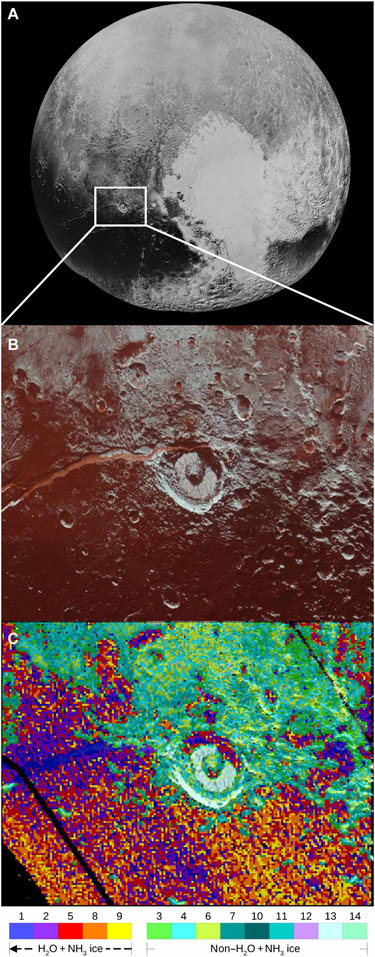A deep red scar on Pluto’s surface may be spraying ammonia-rich water onto surrounding ice. A study published today in Science Advances presents the first detection of ammonia’s chemical signature on the reddish ices west of Pluto’s “heart.”

The researchers believe that the ammonia-rich water originates below Pluto’s surface. “The most likely emplacement mechanism…is that the ammonia–water liquid mixture found its way from the interior and was ‘sprayed’ in a neighborhood of about 200 kilometers from each ‘vent,’” lead author Cristina Dalle Ore, an astrophysicist at the SETI Institute in Mountain View, Calif., told Eos. “We call this mechanism cryovolcanism.”
“Ammonia mixed in water acts like an antifreeze,” she explained, but is short-lived once it is exposed on a planetary surface. Because of that, this detection of ammonia-rich water ice can tell scientists how old Pluto’s surface is, what lies beneath, and how the two interact.
Valley of Ammonia and Ice
Dalle Ore and her team analyzed spectral data of Pluto’s surface collected by NASA’s New Horizons spacecraft when it flew through the Pluto system on 14 July 2015. The researchers focused their analysis on the Virgil Fossae, a series of deep valleys near Elliot crater. These scars are tinted a dark brown-red by substantial amounts of non-ice material and are thought to be the result of geologic activity.
New Horizons measured the near-infrared spectrum of Pluto’s surface at a spatial resolution of 2,700 meters per pixel. The researchers analyzed the spectra of a 5,000-square-kilometer stretch of land encompassing Virgil Fossa, the area’s most prominent valley.
They found several patches that had strong signatures of ammonia ice overlapping the signature of water ice. Other nearby areas also showed evidence of ammonia-bearing molecules without water ice being present. The spatial distribution of ammonia suggests that it came from several cryovolcanic vents in and near Virgil Fossa, the team said.
What’s more, the ammonia must have been deposited on Pluto’s surface relatively recently. “The ammonia molecule is fragile,” Dalle Ore explained, especially when mixed into water. “When exposed to ultraviolet or cosmic ray irradiation, [it] lasts only on the order of millions of years, a short time compared to the age of Pluto itself.”
“Having found ammonia mixed in water ice on the surface of Pluto implies that in the fairly recent past it was emplaced there,” she said.
What Lies Beneath
Despite Pluto’s frigid surface, a balmy –230°C, liquid water can still exist beneath its surface. Radioactive decay of its rocky core heats Pluto from the inside. Chemical mix-ins could also lower the ocean’s freezing temperature.
This new discovery supports the existing theory that “there might be a submerged ocean, or at least some pockets of liquid water, under Pluto’s icy crust in correspondence of Sputnik Planitia,” Dalle Ore said. “We still don’t know the extent of the ocean, if it is a large body of water, or a few disjointed ones.”
—Kimberly M. S. Cartier (@AstroKimCartier), Staff Writer






